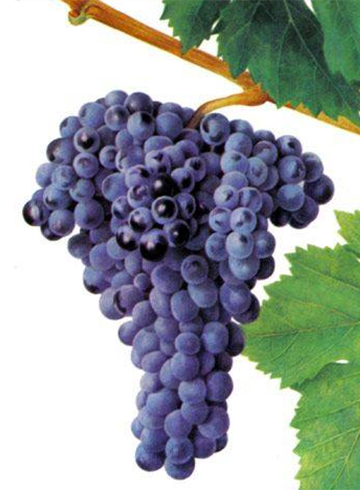Tavkveri is an excellent wine grape, widespread in Eastern Georgia. Unfortunately, it is still not known exactly where its name comes from. In this respect, Tavkveri is not unique. The names of Georgian grape varieties, despite their diversity and antiquity, and therefore their ethnographic, linguistic and historical significance, have been little studied.
There are two theories about the name "Tavkveri". One of them (Iv. Javakhishvili) derives it from the words "TAV-" (head) and "KVERI" (a round, baked pastry with a crust), having that the grain of Tavkveri resembles this bread. The second theory connects Tavkveri with Thakveri Principality (modern Lechkhumi) and offers a version of the Lechkhumi origin of the grape breed.
For me, none of these versions sound reliable, because, first of all, the grain of Tavkveri does not look like a pierced cake at all. On the other hand, it is not clear how could this variety disappear in Lechkhumi itself, or why the additional "v" appeared in the current name of Tavkveri (soundness does not require it. On the contrary, the additional "v" makes it relatively difficult to pronounce).
More to this, the stem "TAV" in the name of other Georgian grapes never refers to a grain, but to a cluster. These are: "Tav-dakiduli", "Tav-tsetskla", "Tav-tsitela". In all these cases, the stem TAV- refers to a bunch/cluster: "Cluster-down", "Cluster-fire" (it has pink-grained grapes), and "Cluster-red" (the side exposed to the sun turns red). Hence, it is not clear why should the stem TAV- refer to the grain only in the case of "Tavkveri".
Neither a grain of Tavkveri resembles a KVERI (pierced round bread) nor its cluster. Tavkveri grape has a medium-sized, strong grain. It is neither flat nor pierced. It does not seem to have any resemblance to a KVERI bread.
The Tavkveri cluster is a stout, large and conical cluster. As a rule, it is characterized by an additional spike, which is smaller compared to the main part of the cluster, although it sometimes accentuates the conical shape of the cluster.
The root KVER- is found in at least two meanings in the Georgian language. One is the mentioned pierced bread, and the other is a sledgehammer, a forge hammer. As for the first one, i.e. the pierced round bread, at first glance, it must have had a ritual purpose. Otherwise, I don't think that the hole and roundness can be explained by culinary necessity. KVERIs were actively baked in villages until the middle of the 20th century, they were baked in a bakery, usually together with other pastries, and people rarely understood their old meaning. According to its shape, the KVERI reminds us of a ritual bread of the sun. It is obvious that bread and the sun are inseparable members of the same mythological paradigm, but it seems that the ritual bread was always given a round shape.
The etymology of the word KVERI is unknown, but we can assume that it must be related to the sun and light, or to the deity associated with it. Such is the KVIRIA deity of the old Georgian pantheon, that “rolls a golden ball (the sun) on the sky”. In my opinion, KVER-, which refers to a ritual bread, should be related to KVIRIA as the sun-deity as well. Here we can recall the baked beans pastry (variety of KVERI) for BARBALE deity (another sun deity), which is also made with hole in the middle). Be that as it may, the round, pointed ritual bread does not in any way resemble neither a grain nor, even more, a cluster of a Tavkveri grape. However, its relation to the sun and, probably, to KVIRIA itself ("Kvir-i" / "Kver-i"?) is clear.
However, there is another meaning of the same root (KVER) with a different meaning and different origin. It seems to be of Indo-European origin and comes from the root "Kwer" which has three meanings: "to do", "to make", and "to build". This stem is so old for Georgian that it seems to have been in the language for a long time and has also acquired a verb meaning: “[gamo]kverva” (forge-out). We also have idioms (e.g. “KVERIS DAKVRA” – hit the hammer – meaning “agree”, “decide”), etc. There is no doubt that one of the meanings of the stem KVER- is related to the demiurge's working tool, the forge hammer.
A large and dense cluster of Tavkveri reminds us of a KVERI-hammer. Therefore, considering several mentioned factors (that TAV- cannot be a grain, that KVER- does not mean only a ritual bread), we must assume that "TAVKVERI" means the “hammer-head grape" and this grape was named because of its large, dense bunch.
In addition to the issue, it can be said that if it is really possible to connect the naming of this grape with the Thakveri Principality anyway (but, this needs to be proved, at first), then we must conclude that after bringing it to Kartli, the so-called “public etymology" played the role and, because of the similarity of Tavkveri cluster with a forge hammer (KVERI), an additional "v" appeared in the word, to denote “head” (TAV). However, if the Thakveri Principality theory cannot be proved, then we must consider the TAVKVERI grape an original Kartli variety and consider its first "v" in the root primary.
In any case, "Tavkveri" given in its present form refers to a cluster similar to a blacksmith's hammer. This can be considered its etymology.
Andro Barnovi


 read in full
read in full
 read in full
read in full
 read in full
read in full



